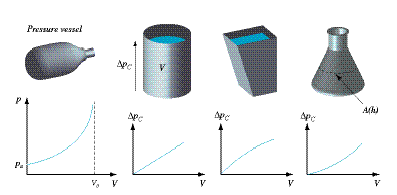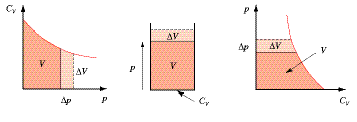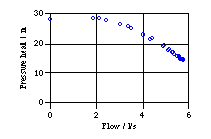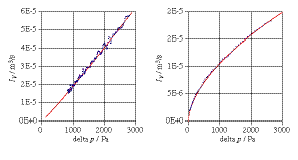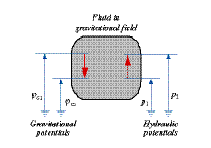5. Constitutive Laws: Storage, Pumps, and Flows | | 
| | Constitutive laws, or special laws, are relations that depend upon the types of elements and fluids used in a system, and upon circumstances. In contrast to the laws of balance or the loop rule, they are not general. They describe the peculiarities of processes and objects. Much of the work in physics goes into constructing useful constitutive laws. | |
Storage of fluids Storage elements are responsible for the dynamics found in (hydraulic) systems. They work by providing a relation between amounts of stored fluid and the pressure difference set up across them. Capacitive characteristic. If fluids are stored in tanks or pressure vessels, the pressure difference increases with increasing amount of stored fluid. There is a relation between the volume stored and the associated pressure difference (which we call a capacitive pressure difference delta_pC). The relation is called a capacitive characteristic (Figure 1 and 2). Elastance and hydraulic capacitance. The characteristic can be expressed mathematically by the elastance alpha_V, i.e., the factor which tells us how easy it is to increase the pressure with a given amount of fluid:  1.14 1.14
alpha_V is equal to the slope of a tangent to the characteristic curve (Figure 1). The unit of elastance is Pa/m^3. | | The hydraulic capacitance C_V (units m^3/Pa) is defined as the inverse of the elastance (C_V = 1/alpha_V):  1.15 1.15
For a liquid of density rho in an open container the capacitance is  1.16 1.16
Equ. 1.15 suggests a way to determine volume changes from pressure changes if the capacitance is known as a function of pressure (Figure 3). | |
Pumps Pumps come in many different types and forms, ranging from the heart to microengineered or large industrial pumps. Pump characteristics. Pumps set up pressure differences, and fluid flows pass through them. Therefore, we define their operation by describing the relation between the these quantities. A simple model of a continuous flow pump is one in which the pressure difference delta_p_P is constant. Real pumps commonly have a more complicated type of characteristic which also depends upon the efficiency (Figure 4). Pressure-volume diagrams are used to represent the operation of intermittently acting pumps such as the heart (Figure 5). | |
Resistive fluid flow When fluids flow through pipes, their pressure drops in the direction of flow because of fluid friction. This pressure drop is called a resistive pressure difference delta_pR, and it is characteristic of the flow which, in turn, depends upon fluid properties and pipe dimensions. Flow characteristic. The relation between the resistive pressure drop DpR and the associated volume current is called the flow characteristic (Figure 6). It allows us to calculate flows if we know the associated pressure difference, or vice-versa. There are two types of flow (laminar and turbulent) leading to two different characteristic curves. Types of flow and Reynolds number. There are two types of flow: laminar and turbulent. Usually, turbulence sets in when a combination of flow speed, fluid viscosity, density, and pipe dimensions called the Reynolds number reaches a critical value. The Reynolds number is defined by Re = rho·v·D/eta. In the case of a pipe, D denotes the diameter. eta and rho are the viscosity and the density of the fluid, respectively. In smooth circular pipes, the transition from laminar to turbulent flow occurs at Re = 2300 or below. Flow speed. The fluid speed is related to the volume flux and the cross section A of the conduit:  1.17 1.17
Laminar Flow. For laminar flow, the characteristic relation is linear (Figure 6, left). In this case, we can write the flow law with the help of a hydraulic conductance G_V (units m^3/(s·Pa)) or its inverse, the hydraulic resistance R_V (units Pa·s/m3):  1.18 1.18
There is an expression for the hydraulic conductance or resistance for laminar flow in pipes with circular cross section which is called the law of Hagen and Poiseuille:  1.19 1.19
r and l are the radius and length of the pipe, eta is the viscosity of the fluid. The viscosity of a fluid tells us how “thick” it is. Turbulent flow. In turbulent flow, the flow increases less rapidly with an increase of the associated pressure difference (diagram on the right of Figure 1):  1.20 1.20
This simple relation suffices as a first approximation. k is called the turbulent flow factor. This factor is similar to a conductance, however, the terms resistance and conductance are only used for laminar flow. | |
Changing fluid speed There is a pressure difference (called the Bernoulli pressure difference) associated with changes of flow speed along a flow line (Figure 1, the pressure decreases if the flow speed increases):  1.21 1.21
Gravity and height differences Hydrostatic pressure. For fluids which are “stacked” in a gravitational field there is a simple relation between pressure difference and height difference (Figure 2). It can be derived from observations (Figure 3):  1.22 1.22
This relation is correct for constant density only. The gravitational potential. Pressure differences are interpreted as hydraulic driving forces, pressures are hydraulic “levels.” For fluids stacked in the gravitational field, vertical pressure differences are the result of gravity. Combining hydraulics and gravity leads to  1.25 1.25
This result is interpreted in Figure 4. The factor gh is the so-called gravitational potential. | | | |

